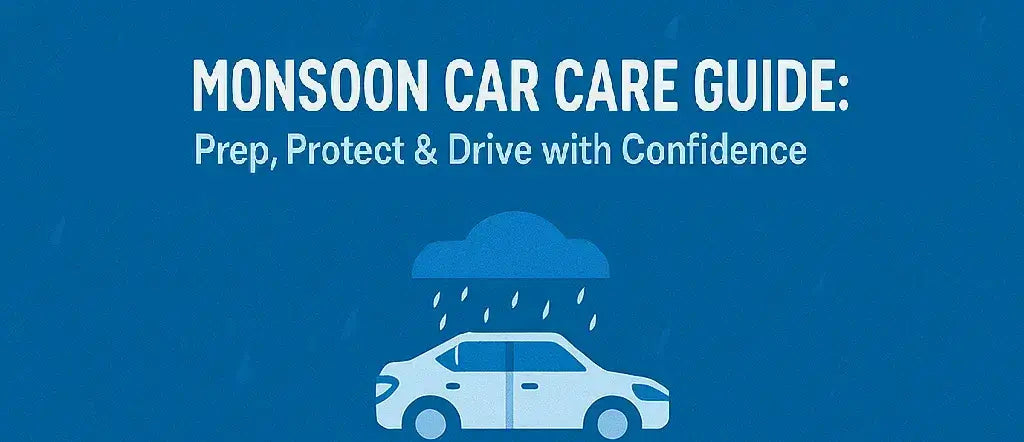
🌧️ Monsoon Car Care Guide (2025): Prep, Protect & Drive with Confidence in India
Share
Monsoon Car Care Guide (2025): Prep, Protect & Drive with Confidence in India
The Indian monsoon brings cool weather and relief from the summer heat, but it’s also one of the most challenging times of the year for car owners. Potholes, waterlogged streets, constant rain, and high humidity make driving and maintaining your car far more stressful. In fact, auto service centers report that nearly 60% of annual car complaints in India occur between June and September, and most of them can be avoided with the right care and preparation.
This guide will help you get your car ready for the rainy season, protect it from damage, and ensure your drives are safe and comfortable.
Why Monsoon Car Care Is Critical in India
Driving during the monsoon is different from any other season. The challenges include:
Potholes and muddy roads: These can damage tyres, suspensions, and underbodies.
Flooded streets: Water can enter the engine or cabin, causing expensive repairs.
Foggy windshields and mirrors: Reduced visibility leads to accidents.
Rust and corrosion: Prolonged moisture can eat into your car’s metal and paint.
Electrical issues: Water and exposed wiring can cause system failures.
With a little preparation, you can avoid most of these problems and keep your car running smoothly through the season.
Step 1: Protect Your Car’s Exteriors and Paintwork
Rainwater in cities is often slightly acidic due to pollution, which can damage your car’s paint over time. When combined with road grime and mud, it can quickly lead to rust spots.
How to protect your car:
Apply a ceramic coating or wax sealant to form a protective layer over the paint.
Use a water-repellent spray on windshields and windows to improve visibility.
Invest in a breathable car cover, not a cheap plastic one, to prevent trapped moisture.
Pro Tip: If you’re parking in unknown or open areas, keep a foldable waterproof cover handy to protect your car during sudden downpours.
Step 2: Keep Windshields and Mirrors Fog-Free
One of the most dangerous monsoon hazards is fogged-up glass, which can reduce visibility by up to 70% in some cars without proper climate control. Poor visibility can lead to accidents, especially on highways or poorly lit streets.
How to prevent fogging:
Apply anti-fog treatments or install fog-resistant films on your windshield and mirrors.
Use your car’s defogger correctly, and keep the AC running on recirculation mode to balance humidity.
A clear view can be the difference between a safe journey and a dangerous one during heavy rain.
Step 3: Protect Electrical Components
Monsoon water doesn’t just harm metal parts—it can wreak havoc on your car’s electrical system, leading to problems like power window failures, battery drains, and central locking malfunctions.
How to protect your car’s electronics:
Seal exposed wires under the hood to keep water out.
Apply dielectric grease to your battery terminals to prevent corrosion and power loss.
Avoid DIY high-pressure washes during heavy rain, as water can seep into sensitive areas.
Keeping your car’s electronics safe ensures that you don’t get stranded due to minor electrical issues.
Step 4: Check Your Tyres and Brakes
Your tyres and brakes are your car’s lifeline in the rain. With wet and slippery roads, their performance is more important than ever.
Tyre and brake checklist:
Check tyre tread depth: Make sure you have at least 3mm of tread left to prevent hydroplaning.
Increase tyre pressure by +2 PSI over the regular recommendation to counter natural air pressure drops in cold, wet weather.
Inspect your brake pads, discs, and ABS sensors. Brakes wear faster in wet conditions, so replace worn parts promptly.
Step 5: Keep Interiors Dry and Odor-Free
Humidity, wet shoes, and fabric seats can turn your car interior into a breeding ground for mold and bacteria. Musty smells and fungus can make your drives uncomfortable and unhealthy.
How to keep interiors fresh:
Use silica gel packs or activated charcoal deodorizers to absorb moisture and odors.
Switch to rubber floor mats for easy cleaning and drying.
Air out your car daily: Leave doors open for 5 minutes when parked safely to allow moisture to escape.
Install door visors so you can crack your windows slightly for ventilation even in the rain.
Step 6: Check Wipers, Washer Fluid, and Lights
A simple but essential step: wipers and lights are your best friends during a downpour. Worn-out wipers and dull headlights can turn a rainy drive into a nightmare.
Monsoon checklist for visibility:
Replace wiper blades every 6–8 months, even if they look fine.
Use alcohol-free windshield washer fluid to avoid streaks and smudges.
Clean and check your headlights and tail lamps for maximum brightness.
Extra Tips for Safe Monsoon Driving
1. Slow Down: Wet roads can double your braking distance. Drive at lower speeds, especially in heavy rain.
2. Avoid Deep Water: If water is higher than the bottom of your bumper, don’t attempt to drive through—it can cause engine damage.
3. Use Hazard Lights in Low Visibility: Let other drivers know you’re there.
4. Service Your Car Before the Rains: A pre-monsoon check can catch small issues before they become big problems.
5. Keep Emergency Supplies: Carry a torch, first aid kit, and a basic tool kit in case of breakdowns.
Final Thoughts
The monsoon season in India doesn’t have to mean stressful or unsafe driving. With the right care and preparation, you can keep your car protected, avoid unnecessary repairs, and drive with confidence.
By focusing on your car’s exteriors, visibility, electrical systems, tyres, interiors, and safety gear, you can make every journey smoother and safer—even in heavy rain.
Taking these steps not only saves you money on potential repairs but also helps keep you and your passengers safe during one of the most challenging driving seasons of the year.
Looking for top-quality car accessories? Visit our Flexx Garage Store for the latest automotive gadgets and gear.
